
Introduction: Small Space, Big Potential
A playroom is more than just a place for kids to store their toys—it’s a space where creativity, imagination, and fun come to life. But what if you don’t have a dedicated room? What if you’re working with a small corner, a shared living area, or even just part of a bedroom? Does that mean you have to sacrifice style, color, and functionality?
Not at all.
With the right approach, a small playroom can be just as vibrant, engaging, and spacious-feeling as a larger one. The key is in how you use color, maximize storage, and choose decor that brings life to the space without overwhelming it. A well-planned bright and colorful playroom can make even the tiniest area feel open, inviting, and full of energy.
In this guide, we’ll explore the best ways to use color, smart design tricks, and creative storage solutions to transform any small space into a functional and stylish playroom. Whether you love pastels, seasonal color themes, or bold accents, you’ll discover how to bring the perfect balance of color and practicality to your child’s space.
Playroom products we recommend






1. Choosing the Right Colors for a Small Playroom
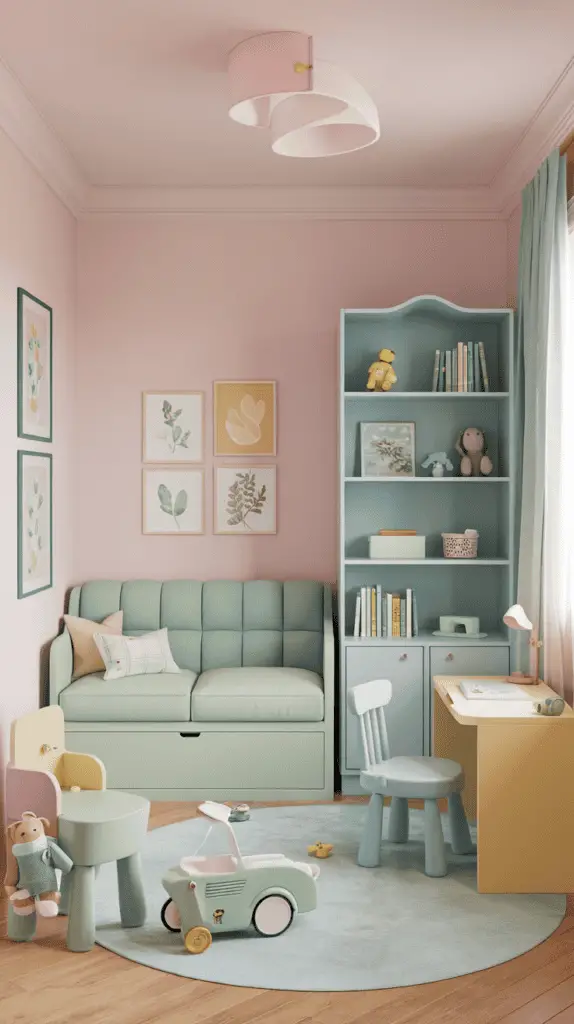
When designing a small space playroom, color is one of the most powerful tools at your disposal. The right colors can make the room feel larger, more open, and inviting, while the wrong ones can make it feel cramped or chaotic.
Light and Airy Pastels
Soft, pastel shades are an excellent choice for small playrooms because they add color without overwhelming the space. Unlike bold primary colors, which can sometimes feel overpowering in a compact area, pastels provide a soothing and fresh aesthetic.
• Pale pink adds warmth without being too bright.
• Mint green is refreshing and works well in gender-neutral designs.
• Light blue brings a sense of calm while keeping the space playful.
• Soft yellow adds a cheerful touch without feeling harsh.
Pastels work well as wall colors, furniture accents, or decorative elements. You can use a neutral base, like soft white or beige, and layer in pastel tones through decor, rugs, or storage bins for a cohesive look.
Seasonal Color Schemes for a Dynamic Look
If you love the idea of refreshing the space over time, consider using a seasonal color scheme. A spring-inspired palette with light greens, floral pinks, and sunny yellows creates an airy feel, while a summer theme might introduce soft ocean blues and coral hues.
A seasonal approach doesn’t mean repainting the walls—it can be as simple as switching out wall decals, throw pillows, or storage baskets to match the mood of the season.
Accent Colors for Playful Energy
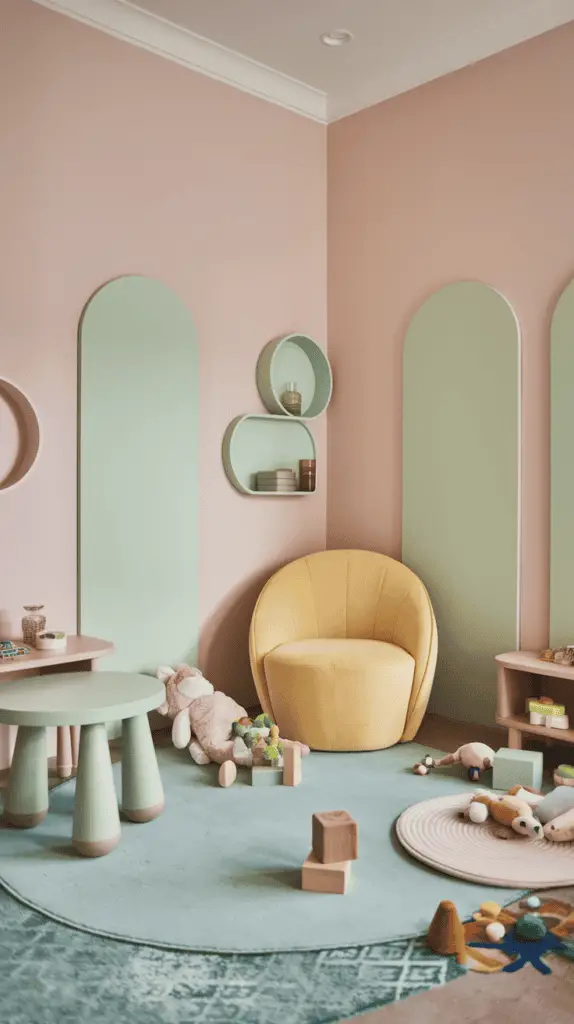
If you love brighter colors but don’t want to overpower a small space, introduce accent colors through carefully selected decor pieces. Instead of painting the entire room in bold hues, add bursts of color with:
• A bright area rug to define the play space.
• Wall decals or framed artwork featuring playful color combinations.
• Storage baskets in vibrant shades to add personality without clutter.
Accent colors work best when used sparingly in small spaces, ensuring they enhance the room rather than overwhelm it.
2. Using Color to Make a Small Playroom Feel Bigger
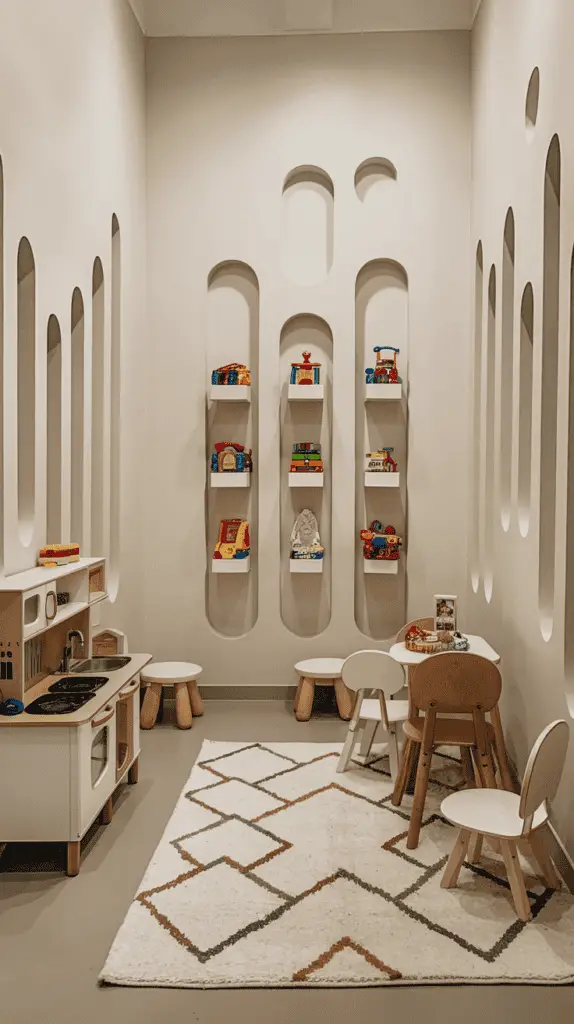
Color doesn’t just affect mood—it also influences perception of space. In a small playroom, certain color techniques can help the room feel more open and airy.
Keep Walls Light for an Expansive Feel
Lighter wall colors reflect natural light, making a space feel larger. If the playroom is in a shared area, like part of the living room, a neutral or pastel wall color can create a seamless flow between the spaces.
If you want to incorporate bolder hues, try painting just one feature wall or using color-blocking techniques to separate different play zones without closing off the space.
Incorporate Vertical Color to Add Height

One trick to make a small room feel taller is to use vertical color elements. A striped accent wall, tall bookshelves in a soft pastel shade, or vertical storage solutions in varying tones draw the eye upward, giving the illusion of height.
Another option is painting the ceiling a very light version of the wall color to create an airy, uninterrupted look.
Use Rugs & Floor Color to Define Play Areas
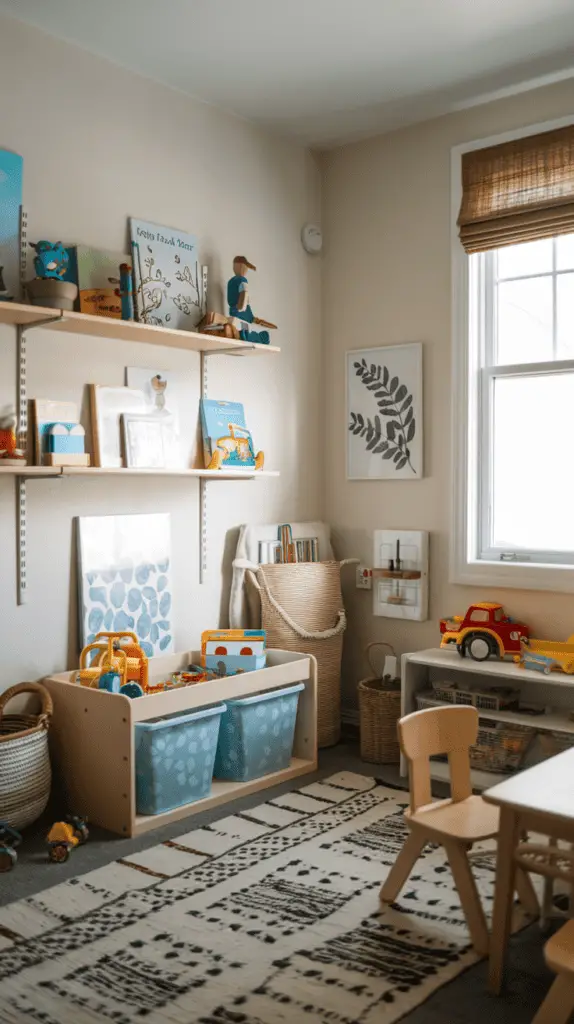
Color doesn’t have to be limited to walls—a playful, patterned rug or pastel foam play mats can define the play area while making the space feel cohesive. A rug in soft blues, yellows, or greens adds warmth without cluttering the space visually.
3. Maximizing Storage While Keeping It Stylish
Storage is one of the biggest challenges in a small playroom. Without a proper system, toys can quickly overtake the space, making it feel chaotic. The goal is to balance organization and aesthetics so that the playroom remains functional without sacrificing color and style.
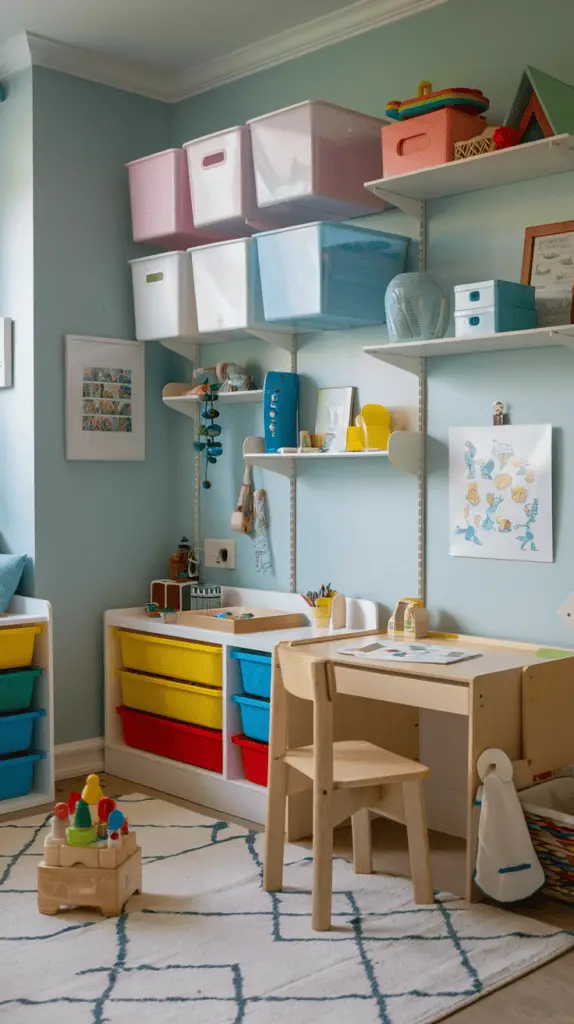
Color-Coded Storage for Easy Organization
Using color-coded bins and baskets makes it easier to keep the space tidy while adding to the room’s visual appeal. Assign different colors for different categories of toys:
• Soft pastels for stuffed animals and plush toys
• Neutral woven baskets for books and puzzles
• Bright pops of color for building blocks and art supplies
This method helps children quickly recognize where things belong, making clean-up time easier.
Floating Shelves & Wall-Mounted Storage
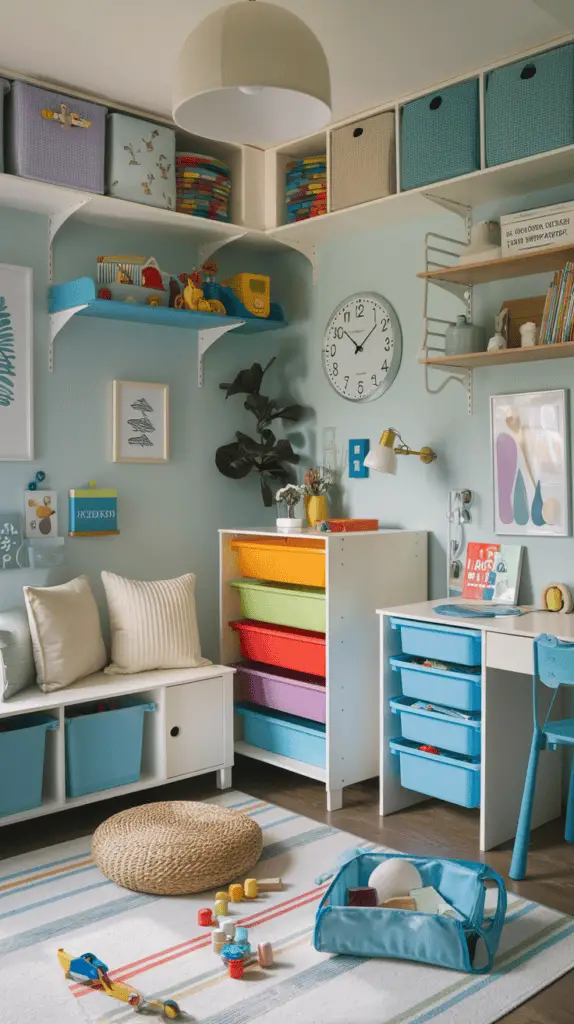
For small spaces, vertical storage is key. Instead of bulky cabinets, opt for:
• Floating shelves painted in pastel or neutral colors
• Wall-mounted cubbies for books and smaller toys
• Pegboards with colorful hanging storage bins
These options keep the floor clear, making the space feel larger while adding decorative interest.
Multi-Functional Furniture
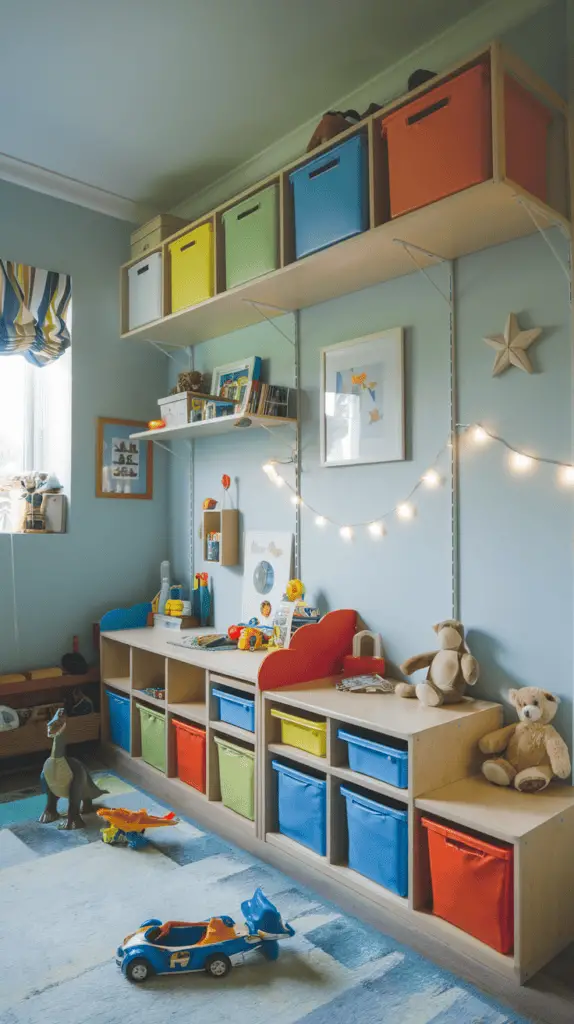
Small spaces benefit from furniture that serves multiple purposes. Some great options include:
• A play table with hidden storage underneath
• Ottomans that double as toy chests
• A window seat with built-in storage for books and games
Choosing multi-purpose pieces in light, cheerful colors ensures the playroom stays both organized and visually inviting.
4. Designing Play Zones with Color & Layout
Even in a small playroom, defining separate activity zones helps create an organized space. Instead of dividing with walls or bulky furniture, use color, rugs, and strategic placement to separate different areas.
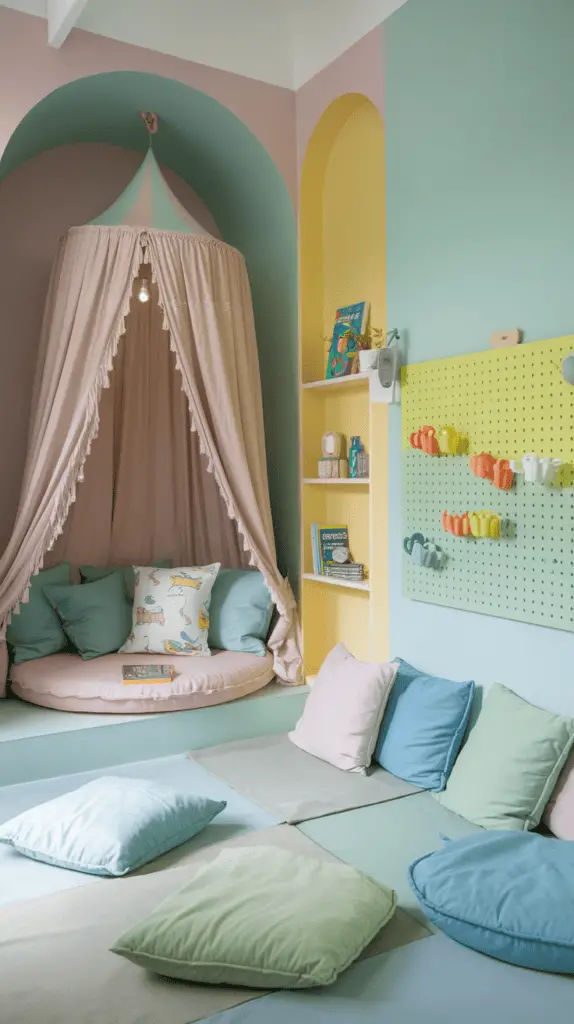
Soft Pastels for a Reading Nook
A small corner with a pastel canopy, floor cushions, and a bookshelf creates a cozy reading space.
Bright, Energizing Colors for an Art Station
A yellow or mint green-painted pegboard can hold art supplies and encourage creativity.
Neutral or Cool Tones for a Relaxation Area
A soft blue or green area with plush pillows offers a quiet space for winding down.
5. Creative Decor Ideas to Brighten a Small Playroom
Once you have the right color scheme and storage solutions, it’s time to focus on decor. A well-decorated playroom sparks creativity and adds personality to the space, making it feel inviting and playful without overwhelming the area.
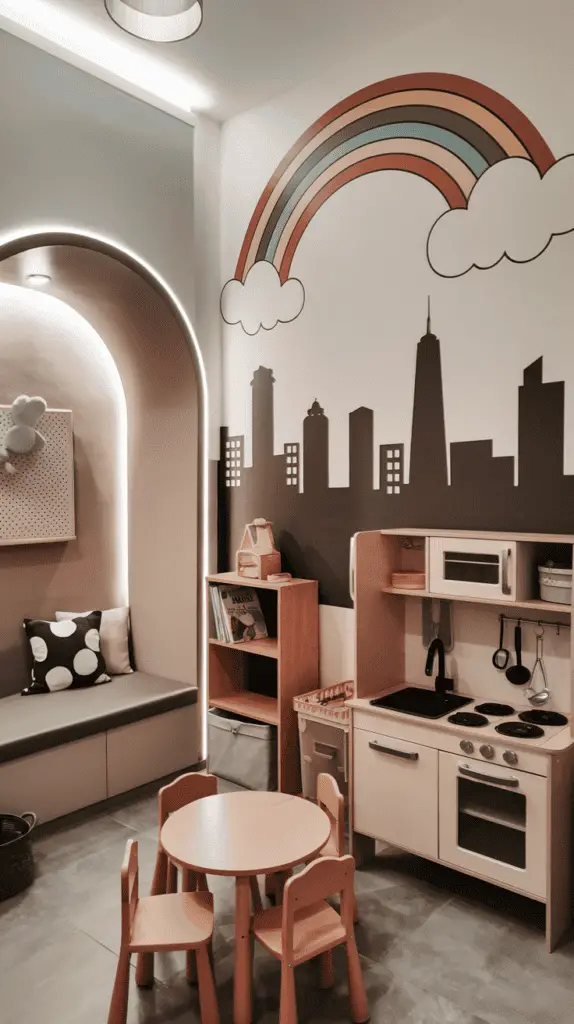
Wall Art and Murals for a Playful Touch
Blank walls in a small playroom can feel dull, but going overboard with too many decorations can make the space feel crowded. The best solution? Strategic wall decor that adds color without cluttering the room.
• Peel-and-stick wall decals: A great way to introduce color without commitment, these removable decals can be swapped out as your child’s interests change. Choose floral, rainbow, or nature-themed decals for a soft, seasonal feel.
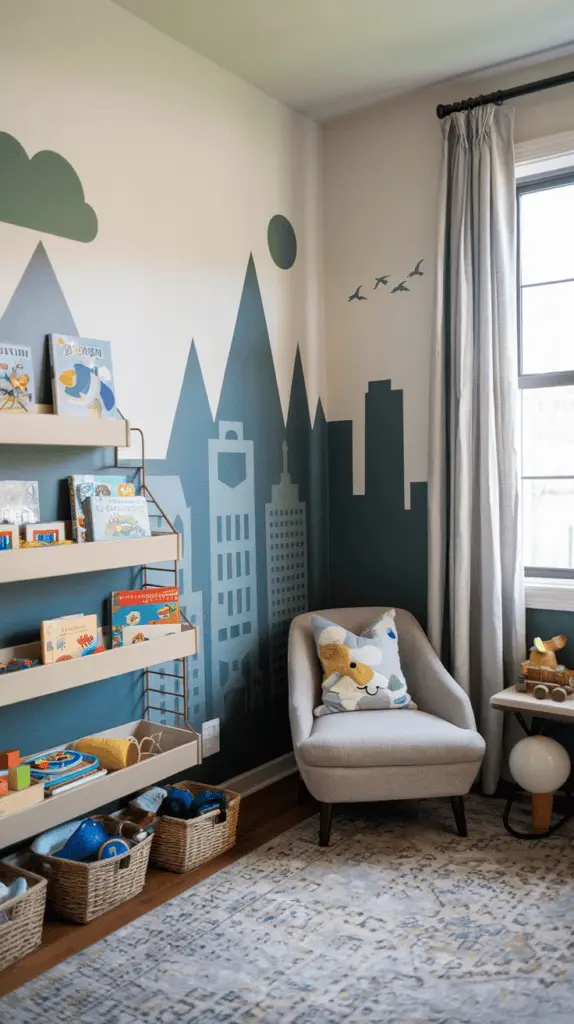
• Simple murals or color-blocked walls: If you’re open to painting, consider a subtle geometric design or soft waves of pastel colors. This adds visual interest while keeping the space calm and airy.
• DIY art displays: Hang a simple rope or wire with clips to showcase your child’s artwork. Frame a few of their best pieces in pastel-colored frames to personalize the space.
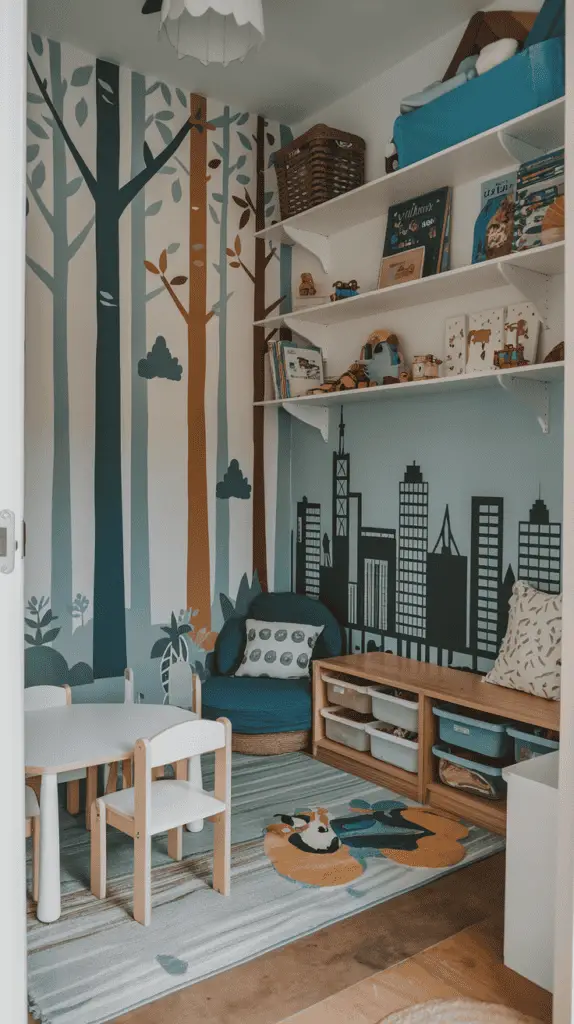
💡 Tip: Keep at least one wall light-colored and uncluttered to maintain an open, spacious feel.
6. Lighting to Enhance Color and Brighten the Space
Lighting plays a major role in how colors appear in a small playroom. A dimly lit room can make even the brightest colors look dull, while well-placed lighting enhances vibrancy and makes the space feel more open.
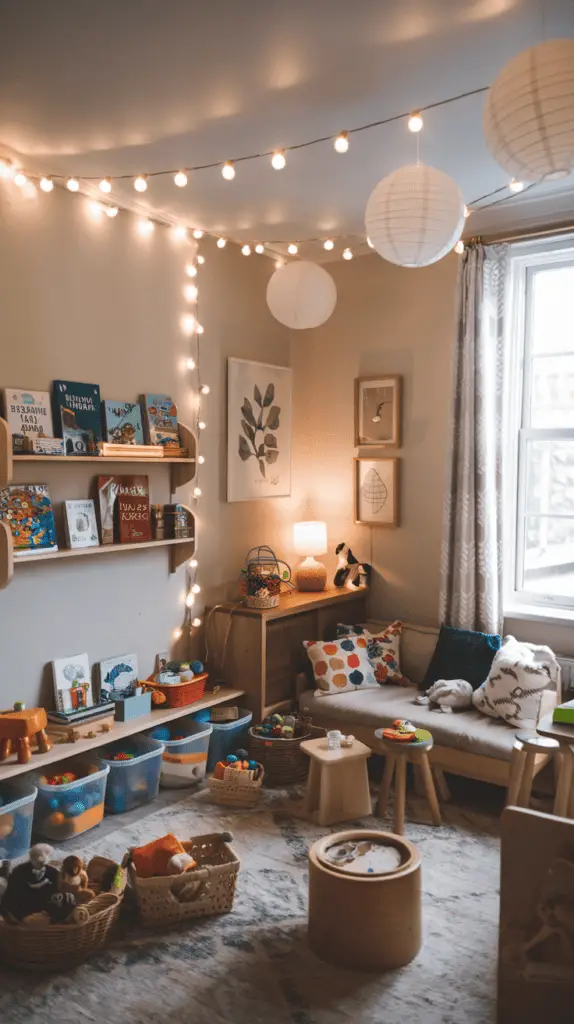
Maximize Natural Light
If your playroom has windows, take advantage of natural light to make the space feel bigger and brighter. Keep window treatments light and airy, such as:
• Sheer white curtains to allow natural light while maintaining privacy.
• Pastel-colored blinds that match the room’s theme.
For playrooms without natural light, mirrors can help reflect light and give the illusion of a more open space.
Layered Lighting for a Cozy Glow
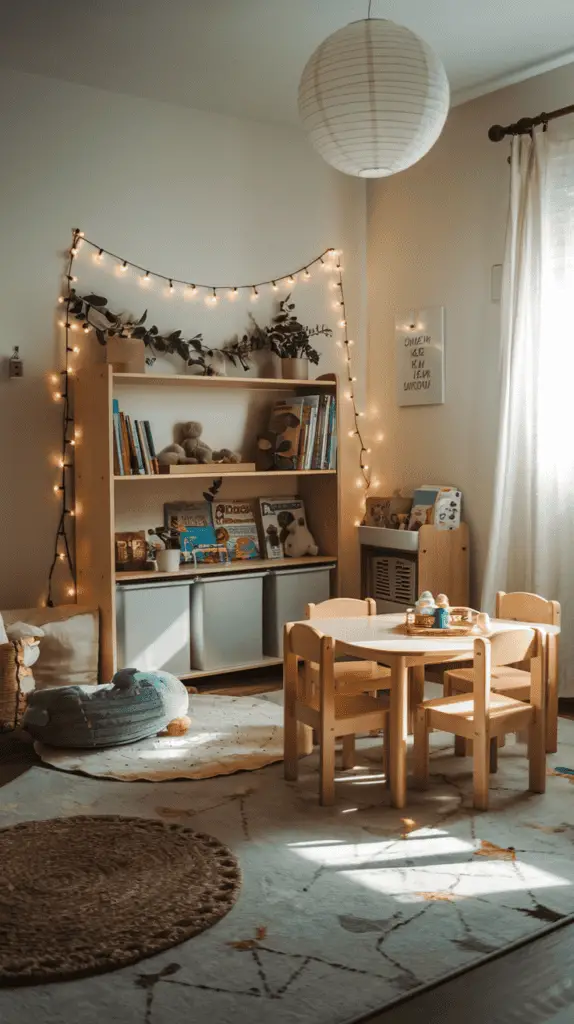
In small spaces, layered lighting helps prevent shadows from making the room feel cramped. Consider using:
• Ceiling lights with warm white bulbs to enhance pastel tones.
• LED string lights in soft colors to create a cozy and playful atmosphere.
• Floor or table lamps with colorful shades to add depth to the room.
💡 Tip: A soft glow from fairy lights or paper lanterns can make the playroom feel magical in the evenings.
7. Multi-Functional Furniture for Small Playrooms
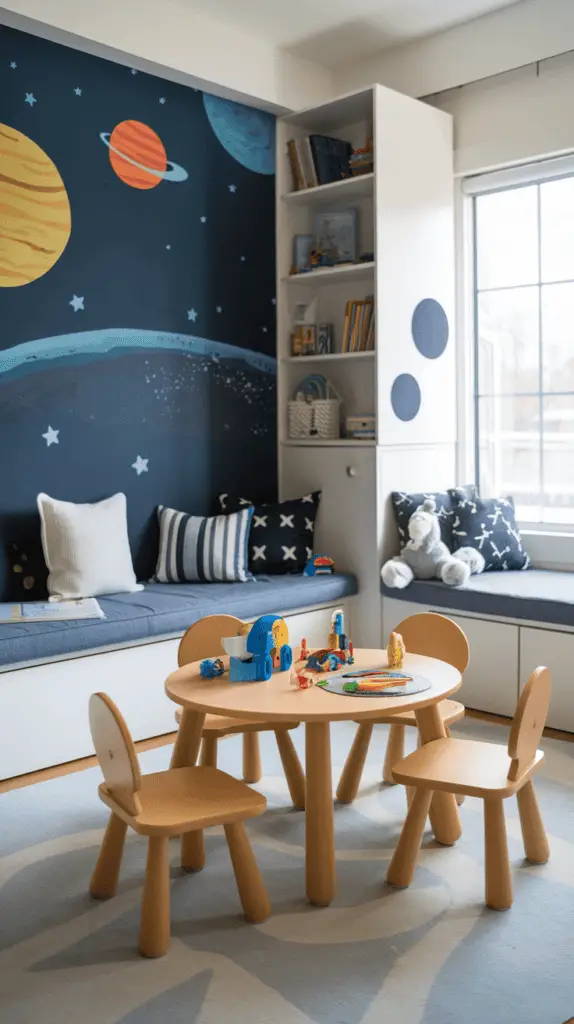
Since space is limited, every piece of furniture should serve more than one purpose. The right furniture choices can help keep the space open while providing storage, play surfaces, and seating.
Space-Saving Play Tables & Seating
Instead of a bulky play table, opt for:
• A foldable play table that can be stored against the wall when not in use.
• A small round table with pastel-colored stools that tuck underneath for a clutter-free look.
• A low Montessori-style play table with built-in storage for art supplies and toys.
Storage Benches and Window Seats
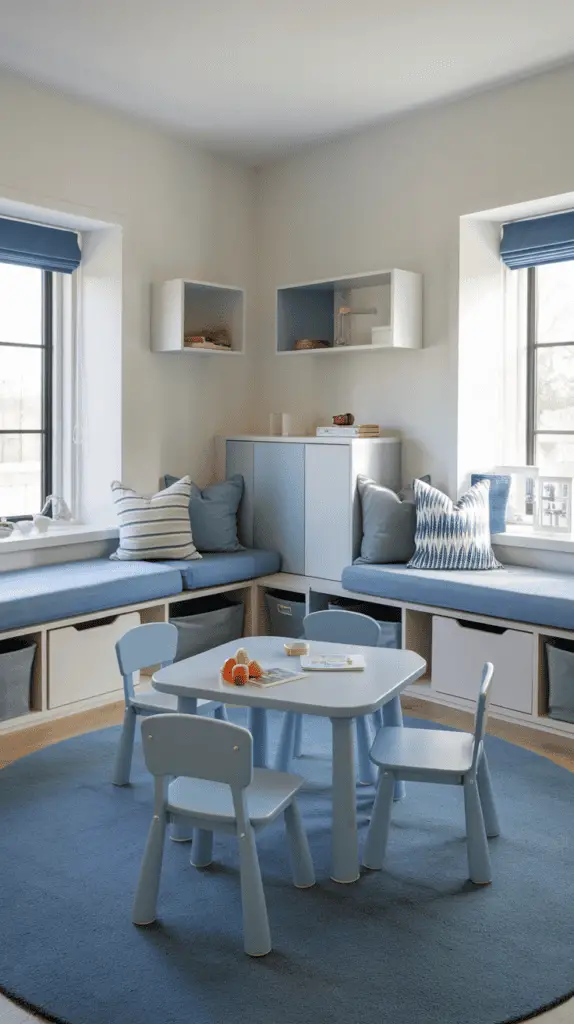
A storage bench along one wall can double as a seating area while housing toys, books, or blankets.
• Use soft cushions in pastel shades to make the seating area cozy.
• Choose a bench with pull-out storage bins for easy access to toys.
• If the playroom is part of a living room, a stylish bench helps blend the space seamlessly.
Convertible Furniture for Flexible Use
• Fold-down desks or wall-mounted play tables free up space when not in use.
• Loft beds with play areas underneath work well for a bedroom/playroom combination.
• Stackable storage crates that double as stools make it easy to reconfigure the space as needed.
💡 Tip: Look for furniture in neutral or pastel tones so it blends with the overall color scheme without overwhelming the room.
8. Designing a Playroom That Grows with Your Child
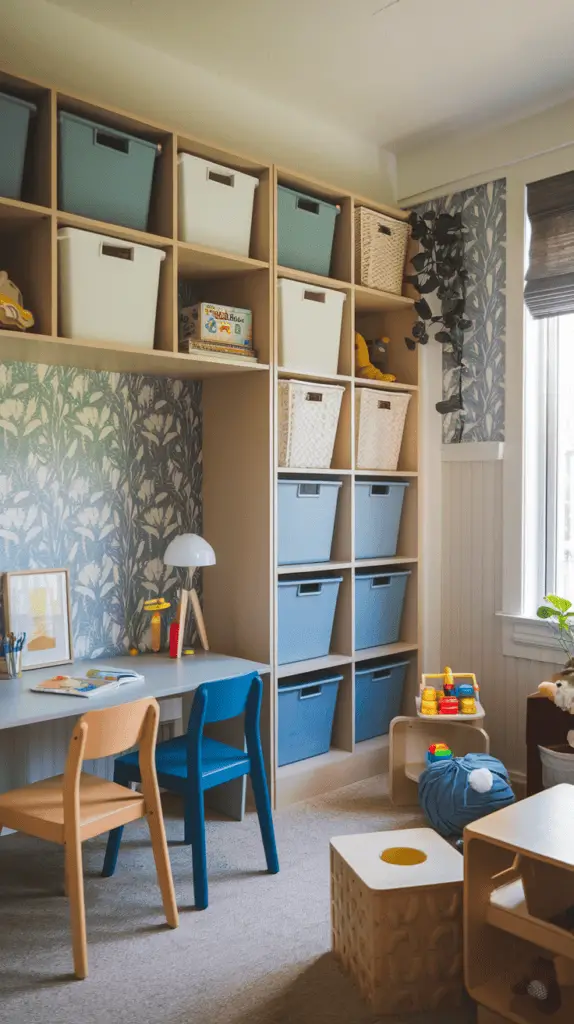
A playroom should adapt as your child grows, so choosing timeless colors and flexible furniture ensures the space remains functional for years to come.
Opt for a Versatile Color Palette
Instead of committing to a theme that might feel outdated in a few years, consider using a mix of soft pastels and neutrals. This way, you can easily update the look with:
• New wall decals or framed artwork instead of repainting the entire room.
• Swapping out storage bins or rugs to refresh the color scheme.
• Using removable wallpaper for a temporary pop of color.
Modular Storage for Changing Needs
A modular storage system grows with your child.
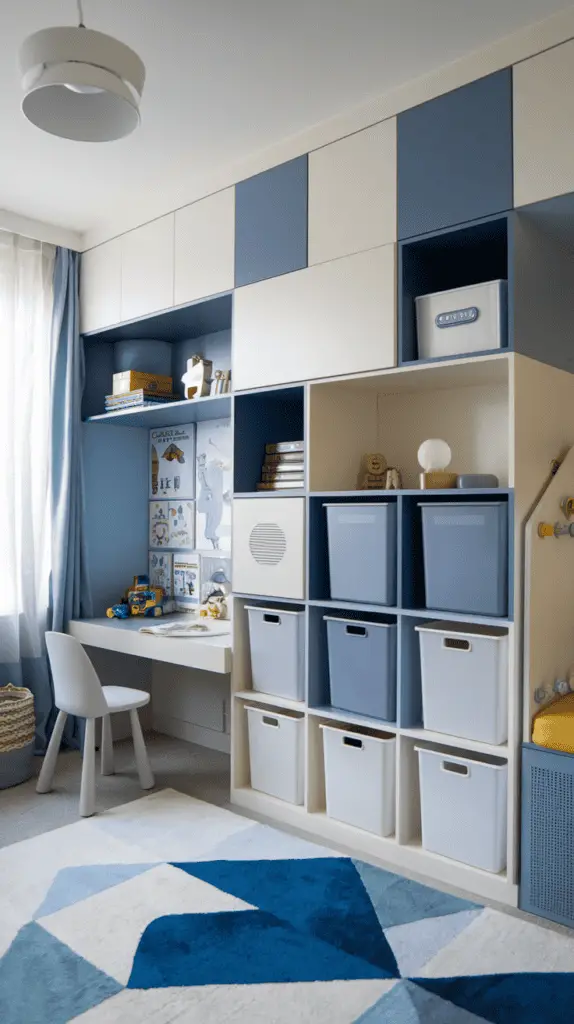
• For toddlers: Low, open shelves with pastel fabric bins make it easy to grab and put away toys.
• For older kids: Adjustable shelving units can accommodate books, art supplies, and schoolwork.
• For shared playrooms: A mix of color-coded storage solutions helps keep toys and activities separate.
Incorporate a Study or Reading Area
As children grow, they’ll need a dedicated space for reading, homework, or creative projects. Even in a small playroom, you can create a cozy study corner by:
• Adding a small floating desk with a pastel chair.
• Using wall-mounted bookshelves to save space.
• Introducing soft lighting and a comfortable floor cushion for a relaxed reading nook.
💡 Tip: A foldable or adjustable desk ensures the space remains flexible as your child’s needs change.
Final Thoughts: Bringing Color, Function, and Fun to a Small Playroom
A bright and colorful small playroom is all about balancing color, smart organization, and practical furniture to make the most of every inch. Even the smallest corner can feel like a playful, inviting space with the right approach.
Key Takeaways:
✔ Use pastels and light colors to keep the room feeling open.
✔ Incorporate seasonal or accent colors through decor and storage.
✔ Maximize space with multi-functional furniture and smart storage solutions.
✔ Enhance natural and artificial lighting to make the space feel bigger.
✔ Keep the design flexible so the playroom grows with your child.
By following these ideas, you can design a small playroom that is not only functional but also visually inspiring—a place where kids can play, learn, and grow in a bright and joyful environment.
Playroom products we recommend






